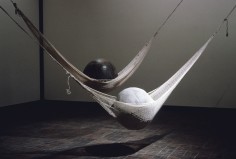toshiko takaezu

source: anyonegir
Toshiko Takaezu, American ceramic artist and painter, made functional wheel-thrown vessels and abstract sculptures, and when she didn’t have access to a kiln, she painted on canvas.
Challenging the traditional boundaries between craft and fine art, Takaezu played a pivotal role in redefining conventional methods of ceramics; by closing the mouths of her clay pots, Takaezu started to distance her works from any preconceived ideas of functionality. Takaezu’s organic and expressively painted artworks draw on the natural world, Japanese tea ceremonies, and Zen philosophy.
By rejecting the rules and reshaping the industry, I am in awe of her quiet dedication to redirect her own practice. Opting to retire and spend her last days as a studio artist, Toshiko Takaezu reminds us to reshape the model to best fit our own agendas, to not make any compromises or short cuts, and to feel that traction of moving forward on a path that you created purely for yourself.
.
.
.
.
.
.
.
.
source: articedu
Toshiko Takaezu: Ceramics not only demonstrates the artist’s commitment to the medium’s sensuous pleasures but also marks her gift of 16 magnificent pieces donated to the Art Institute in 2006. The first exhibition devoted to Takaezu’s work at the museum in almost 50 years, it will feature nearly 20 of the artist’s ceramics from five decades of her career and representative examples by her mentors and contemporaries.
One of the first artists to explore ceramic’s possibilities as an independent aesthetic medium, Toshiko Takaezu revolutionized the field with abstract shapes, painterly glazes, and lyrical installations. Inspired by ceramist Maija Grotell, her teacher at the Cranbrook Academy of Art, Takaezu absorbed a philosophy of irregularity and asymmetry and drew upon diverse artistic influences from Europe, Asia, and the natural world. Takaezu was also strongly influenced by the theories of Hong Kong–born potter Bernard Leach and the works of Hamada Shoji, which taught her the Zen approach of intuition and formal simplification that shaped the artist’s mature style. Through her mastery of ancient firing techniques, Takaezu created earthenware that reached sculptural heights, just as her exploration of surface decoration led her to use glaze with the same expressiveness as abstract painters. Takaezu’s ceramics lucidly articulate the cross-cultural influences of East and West, bridging her American, Hawaiian, and Japanese heritages while announcing her originality and independence.
.
.
.
.
.
.
.
source: artmuseumprincetonedu
While Takaezu’s work recalls traditional Japanese forms and techniques of ceramic production, she was at the vanguard of the movement that elevated ceramics from a craft to an art. One of the innovations of her work was the closed form. Her vessels lack openings large enough to allow them to be used as bowls or jars. Instead, her ceramics convey the powerful interaction between the intention of the artist’s hand, nurturing and cajoling the clay into shape, and the unpredictable environment of the kiln, where splashes and rivulets of colored glaze are formed.
Takaezu often presented her work in specific groupings. Her sculpture Homage to Sawada Tetsuro is accompanied by a painting by a friend of the artist, Sawada Tetsuro; the two works were presented to the Museum as a set. Moon and Night were not originally paired, but their forms seem to gravitate toward each other naturally. Sunrise Egg completes the assemblage.
Toshiko Takaezu was born in Hawai’i to parents who emigrated from the southern Japanese island of Okinawa. She began her study of ceramics at the Hawai’i Potters Guild; later study brought her to Michigan, where she was mentored by the Finnish potter Maija Grotell (1899–1973). In 1955, Takaezu traveled to her parents’ homeland of Japan and studied mingei (folk-craft) ceramics, utilitarian objects prized for their rustic beauty. Upon her return to the United States she began teaching, and from 1967 to 1992 she taught in the Program of Visual Arts at Princeton University.

